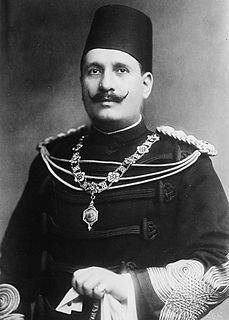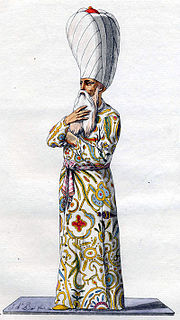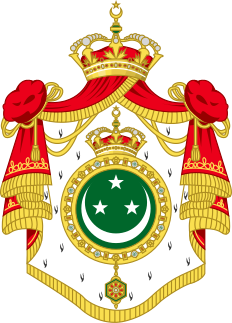Modern Egypt
The Muhammad Ali Dynasty, which ruled Egypt from 1805 until 1953, witnessed three different regencies.
Regency during Muhammad Ali's illness
Ibrahim Pasha presided the Regency Council that was formed on 15 April 1848 to run Egypt due to Muhammad Ali Pasha's declining physical and mental health. Legal documents were still written in the latter's name; however, Ibrahim Pasha became the de facto ruler of the country from this moment on. On 20 July of the same year, an extraordinary envoy of Ottoman Sultan Abdülmecid I arrived in Alexandria with the firman by which the Porte recognized Ibrahim Pasha as Egypt's new wāli. The latter then travelled to Istanbul, where his investiture took place on 25 August in the presence of the Ottoman Sultan. However, his reign was very brief, and his death occurred shortly after his return to Cairo. He died on 10 November 1848 due to ill health, thus predeceasing his father. [2]
Regency during Farouk I's minority
A Regency Council was established following the death of King Fuad I, since his son Farouk was still a minor. Prior to his death, Fuad I had named in a formal document the three members who were to serve on the Regency Council: Adli Yakan Pasha (a former Prime Minister who had already died by the time Farouk I became King), Tawfiq Nasim Pasha (another former Prime Minister) and Mahmoud Fakhri Pasha (a former Foreign Minister married to Fuad I's eldest daughter Princess Fawkia). However, Parliament rejected King Fuad I's choices, and appointed three totally different regents: Prince Muhammad Ali (son of the late Khedive Tawfiq Pasha and thus first cousin of King Farouk I), Aziz Ezzat Pasha (a former Foreign Minister married to Behiye Yakan Hanem, another cousin of Farouk I) and Sherif Sabri Pasha (Farouk I's maternal uncle). The Regency Council was formally sworn in on 8 May 1936 in front of a joint session of Parliament. King Farouk I assumed his full constitutional powers upon reaching his age of majority (fixed at 18 years and calculated according to the Islamic calendar) on 29 July 1937. [3]
Regency during Fuad II's minority

The Revolution of July 1952 did not immediately lead to the abolition of the monarchy. King Farouk I abdicated in favour of his six-month-old son Ahmad Fuad, who ascended the throne as King Fuad II. However, the latter only reigned as a nominal king-in-exile. Initially, his powers were assumed during a week by the Cabinet, headed at the time by Ali Maher Pasha. On 2 August 1952, a temporary regency "body" (not a formal Regency Council) was created. Headed by Prince Muhammad Abdel Moneim (son of the late Khedive Abbas Helmi II and Fuad II's second cousin), the three-member Regency Body also included Bahey El Din Barakat Pasha (a former Minister of Education and Speaker of Parliament) and Rashad Mehanna (a colonel appointed as representative of the Army). The Regency Body was dissolved on 7 September 1952, and Prince Muhammad Abdel Moneim was appointed as sole Prince regent. However, throughout this period, real powers lay in the hands of the Revolutionary Command Council. The monarchy was formally abolished on 18 June 1953: Egypt was declared a republic for the first time in its history, and Muhammad Naguib became its first ever President. [3]












